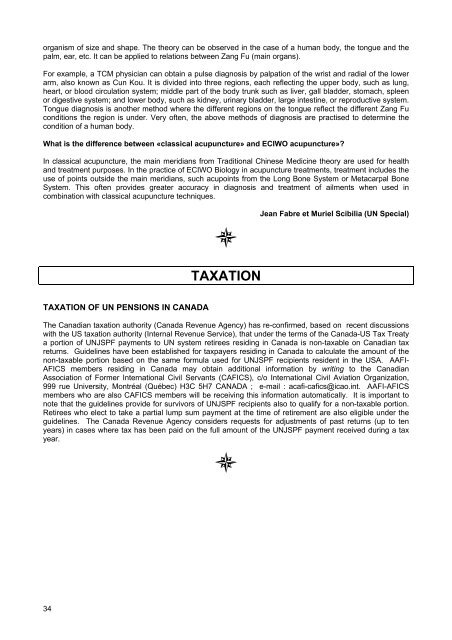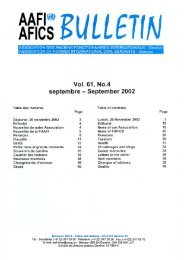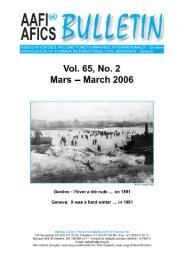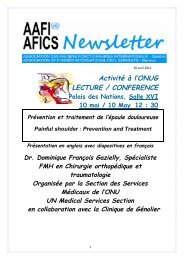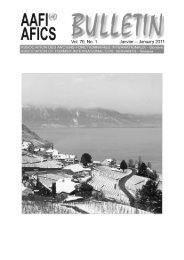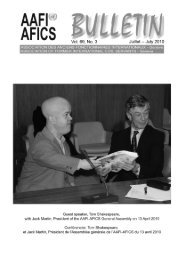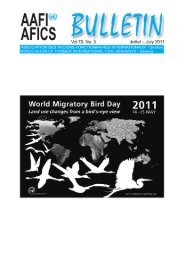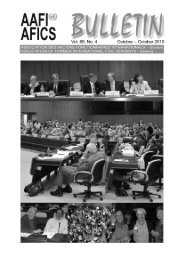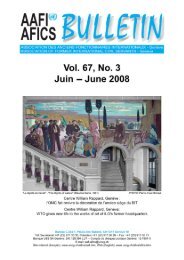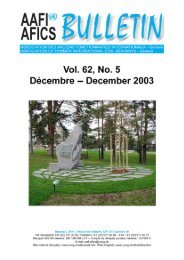VOL. 68, NO. 2 - AAFI-AFICS, Geneva - UNOG
VOL. 68, NO. 2 - AAFI-AFICS, Geneva - UNOG
VOL. 68, NO. 2 - AAFI-AFICS, Geneva - UNOG
You also want an ePaper? Increase the reach of your titles
YUMPU automatically turns print PDFs into web optimized ePapers that Google loves.
organism of size and shape. The theory can be observed in the case of a human body, the tongue and the<br />
palm, ear, etc. It can be applied to relations between Zang Fu (main organs).<br />
For example, a TCM physician can obtain a pulse diagnosis by palpation of the wrist and radial of the lower<br />
arm, also known as Cun Kou. It is divided into three regions, each reflecting the upper body, such as lung,<br />
heart, or blood circulation system; middle part of the body trunk such as liver, gall bladder, stomach, spleen<br />
or digestive system; and lower body, such as kidney, urinary bladder, large intestine, or reproductive system.<br />
Tongue diagnosis is another method where the different regions on the tongue reflect the different Zang Fu<br />
conditions the region is under. Very often, the above methods of diagnosis are practised to determine the<br />
condition of a human body.<br />
What is the difference between «classical acupuncture» and ECIWO acupuncture»?<br />
In classical acupuncture, the main meridians from Traditional Chinese Medicine theory are used for health<br />
and treatment purposes. In the practice of ECIWO Biology in acupuncture treatments, treatment includes the<br />
use of points outside the main meridians, such acupoints from the Long Bone System or Metacarpal Bone<br />
System. This often provides greater accuracy in diagnosis and treatment of ailments when used in<br />
combination with classical acupuncture techniques.<br />
Jean Fabre et Muriel Scibilia (UN Special)<br />
TAXATION<br />
TAXATION OF UN PENSIONS IN CANADA<br />
The Canadian taxation authority (Canada Revenue Agency) has re-confirmed, based on recent discussions<br />
with the US taxation authority (Internal Revenue Service), that under the terms of the Canada-US Tax Treaty<br />
a portion of UNJSPF payments to UN system retirees residing in Canada is non-taxable on Canadian tax<br />
returns. Guidelines have been established for taxpayers residing in Canada to calculate the amount of the<br />
non-taxable portion based on the same formula used for UNJSPF recipients resident in the USA. <strong>AAFI</strong>-<br />
<strong>AFICS</strong> members residing in Canada may obtain additional information by writing to the Canadian<br />
Association of Former International Civil Servants (C<strong>AFICS</strong>), c/o International Civil Aviation Organization,<br />
999 rue University, Montréal (Québec) H3C 5H7 CANADA ; e-mail : acafi-cafics@icao.int. <strong>AAFI</strong>-<strong>AFICS</strong><br />
members who are also C<strong>AFICS</strong> members will be receiving this information automatically. It is important to<br />
note that the guidelines provide for survivors of UNJSPF recipients also to qualify for a non-taxable portion.<br />
Retirees who elect to take a partial lump sum payment at the time of retirement are also eligible under the<br />
guidelines. The Canada Revenue Agency considers requests for adjustments of past returns (up to ten<br />
years) in cases where tax has been paid on the full amount of the UNJSPF payment received during a tax<br />
year.<br />
34


